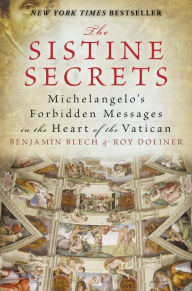From his promising beginings (bit 1) to the greatest artist ever.
The Sistine Chapel is one of the most iconic buildings on earth — but there's a lot you probably don't know about it.
Here there are two bits (2 and 3) to help you out...
ITEM #1 The noble art of forgery in the Renaissance
- At a young age, Michelangelo amassed great wealth that can’t be explained by sales of his original works. With antiquities up to 10 times more valuable than contemporary art during the Renaissance era, forgery was a lucrative profession. “We don’t have enough works like the David that we can connect to [his] money,” said art historian Lynn Catterson. “It means there might be a few more [forgeries by Michelangelo that] we don’t even know about that are hiding in Greek and Roman galleries pretending to be antiquities.”
- Back then, forgery wasn’t considered a crime but instead a sign of artistic ability. It was also a way for young artists to train. Michelangelo built his career on forgeries, although he went beyond mere imitation. When Michelangelo made a painting of Martin Schongauer’s print of Saint Anthony, no one could distinguish between the two works. Michelangelo was skilled at using smoke to age his paintings, so they would look as old as the original.
- In 1496, when he was only 21, Michelangelo copied the marble sculpture Sleeping Eros. Then he buried it to age it with scratches, dents, and stains. Through an art dealer, Michelangelo sold the fake for a large sum of money to Cardinal Raffaele Riario, a Roman antiquities collector.
- Later, when Riario learned he had purchased a fake, he brought the sculpture back to the art dealer. The art dealer eagerly took the return and resold the forged work of the now-famous Michelangelo to someone else.
- In the Renaissance era, experts were often impressed by artists who fooled them. “Whether undertaken as a practical joke, to show that his work was as good as that of the ancients or for reasons of more nefarious intent. As proof, art crime expert Noah Charney in The Art of Forgery wrote: “Cardinal Riario became Michelangelo’s first patron in Rome.”
- That forgiving attitude changed around the late 1800s, when forgery became an immoral deception. In modern times, many art forgers are unsuccessful artists whose own work was disregarded early in their careers. While money is certainly a factor, the main reason for most forgeries is passive-aggressive revenge. Art conservators who are forgers can also counterfeit documents to verify their fakes. That makes it difficult to detect some forgeries. We used to rely on experts to authenticate works of art. However, the fear of costly lawsuits has stopped many art scholars from voicing their opinions, keeping some forgeries in the market and some recently discovered works off the market due to lack of verification.
ITEM #2
December 2015 at TEDGlobal>Geneva (17:33)
Elizabeth Lev:
The unheard story of the Sistine Chapel
ITEM #3
ITEM #3
The Sistine Secrets: Michelangelo's Forbidden Messages
in the Heart of the Vaticanby Benjamin Blech, Roy Doliner
The Shocking Secrets of Michelangelo's Sistine Chapel Artwork: The recent cleaning of the Sistine Chapel frescoes removed layer after layer of centuries of accumulated tarnish and darkness. The Sistine Secrets endeavors to remove the centuries of prejudice, censorship, and ignorance that blind us to the truth about this piece of art.
Enrico Bruschini“Just as the work of Michelangelo in the Sistine Chapel changed forever the world of art, so will this book change forever the way to view and, above all, to understand the work of Michelangelo!”
Los Angeles Times“…(a) fascinating study of the Sistine Chapel. […] Like the best art historians, the authors give us a fresh context for the times, never hesitating to make contemporary parallels. […]This is a stimulating exploration that makes familiar masterpieces seem strange and new.”
- Michelangelo painted his understanding of the function of the brain on the ceiling of the Sistine chapel in Rome. Dr Frank Meshberger wrote an article (1) giving an interpretation of what Michelangleo has actually depicted in the central painting, which shows the creation of man. He shows that by following the main lines, formed by God and the angels in the picture, an accurate outline of the brain is displayed! Perhaps Michelangelo wanted to say that, because of our brain, we ourselves have the potential of becoming Gods.
The authors brilliantly spend about four pages explaining the official story the Vatican offers about the Sistine ceiling and then spends the rest of the book detailing a new interpretation. The research that no doubt was involved is phenomenal!



No comments:
Post a Comment